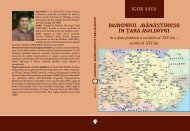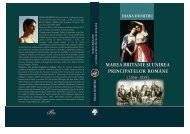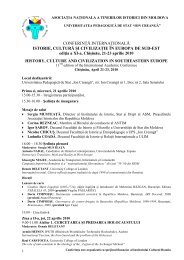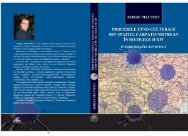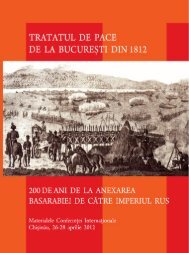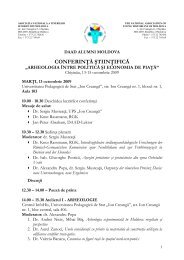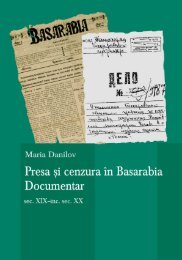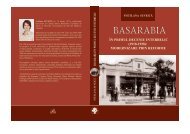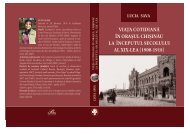Publicatie cu continut integral - Asociatia Tinerilor Istorici din Moldova
Publicatie cu continut integral - Asociatia Tinerilor Istorici din Moldova
Publicatie cu continut integral - Asociatia Tinerilor Istorici din Moldova
You also want an ePaper? Increase the reach of your titles
YUMPU automatically turns print PDFs into web optimized ePapers that Google loves.
intellectuals in Latgale were very active and they declared their pretensions to these land in the 1870s1 . So Polish<br />
and Latvian perceptions of Latgale are opposite each other and in the same time they are mutually exclusive.<br />
Polish intellectuals formated Polish image of Latgale not only in historical studies – Polish literature was not<br />
less nationalistic than historiography and many Polish writers did a lot for integration of local Latgalian images to<br />
general Polish literature and language context. In 1912 Polish poet edward Słoński published in Witebsk volume<br />
of his verses with nationalistic and patriotic title “Z okolic Dźwiny” 2 . By such name he tried to underline that Latgalian<br />
territories belonged to the number of Polish historical lands. By his lyrical and romantic poetry (edward<br />
Słoński for example, wrote: “Ja znam ten kraj, gdzie nie cytryny rosną // nie pyszny laur, nie wonny mitr rozkwita<br />
// Ja znam ten kraj, gdzie wiatr nie palmy muska // lecz w ciemną noc w przydrożnej łka olszynie // ja znam ten<br />
kraj, gdzie stara Dźwina pluska // Ja znam ten gród... Jak z murów tynk zwietrzały // Opada sen z nabrzmiałych<br />
łzami powiek... // - Jakże ty chcesz, żeby zmartwychwstał człowiek // z pod gruzów tych, gdzie bogi umierały?”) he<br />
assisted to formation and strengthening of concept of Latgale as Polish lieux de memoire only.<br />
Modern Polish intellectuals don’t forget such ideas and they continue to develop image of Latgale as image of<br />
inflanty Polskie. For example anonymous author in one of nationalistic sites in Polish internet which is devoted<br />
to Poles in diapora write, that Latgale is not only geographical territory, but element of Polish national spirit, of<br />
Polish national, <strong>cu</strong>ltural and spiritual life: “inflanty Polskie to nazwa geograficzna, która dziś brzmi może dla<br />
niektórych trochę egzotycznie i tajemniczo, ale stanowi bardzo istotny fragment polskiego życia duchowego”.<br />
Plans of establishment of the Greater Poland from Baltic to Black sea hadn’t historical perspectives and Latgale<br />
after the First World War developed as part of Latvia where Polish continued existing but as national minority<br />
only. Historically Polish perception of Latgale as only Polish national heritage, as Polish lieux de memoire assisted<br />
to marginalization of this project. Polish nationalists were not able to tear up this region from Baltic <strong>cu</strong>ltural massive.<br />
So Polish intellectuals were losers and marginals who were forced to cherish their Latgalian memoirs and<br />
narratives in exile or in external opposition. But Polish nationalists were not the only losers in this intellectual war<br />
for Latgale as lieux de memoire – Belarus nationalists sustained more frightful and impressive defeat.<br />
Belarus nationalists later than Latvian, Latgalian and Polish intellectuals tried to integrate Latgale in complex<br />
of their own national narratives. It was result of low development of Belarus national movement in Russian Empire.<br />
Latvian intellectuals in inter-wars period motivated such situation in the next way: Belarus nationalism was<br />
weak and it developed between two poles – between Russian and Polish influence3 . Belarus activity took place in<br />
Latgale during the first half of 20th century age, when this region was realized by Belarus nationalists and intellectuals<br />
as part of future independent Belarus.<br />
In this case they were engaged in conflict with Latvian and Polish states and powerful nationalistic movements<br />
and doctrines in the same time. Belarus nationalists were active and tried to use advantages of post-war situation.<br />
That is why they claimed from newly established Latvian republic to confess their Belarus diplomatically. On<br />
another hand Latgale was good land for Belarus nationalists – here they started such impressive activity which<br />
was impossible in Soviet Belarus. They began to formate their own perception of Latgale. They <strong>cu</strong>ltivated narrative<br />
about Daugavpīls as about Dzwinsk – non Latvian, but Belarus city. In fact majority of Belarus leaders and<br />
national activists in Latvia lived in Latgale. Such prominent politicians as Kastus’ Ezawitaw and Siargei Saharaw<br />
were among leaders of Belarus nationalists in Latgale between two wars4 .<br />
Latgale was one of centers where Belarus nationalists tried to support and develop Belarus <strong>cu</strong>lture and identity.<br />
Local Belarus intellectual leaders in such situation had influenced on Latgalian region not very much, but they<br />
tried to use situation when many inhabitants of Latgalian region did not have expressive and obvious national<br />
identity5 . For their national needs Belarus intellectuals in Latgale were active in local political life, quite often<br />
wrote in Latvian and try to popularize their ideas about Latgale as Belarus lieux de memoire among Latvian politicians6<br />
. Belarus politicians of Latgale in inter-war period widely used experience which they got in 1919 – 19207 .<br />
1 MANTEUFFEL, 1879.<br />
2 SŁOŃSKI, 1912.<br />
3 KEMPS, 1991; KRASNAIS, 1938.<br />
4 LIS, 1997, 329 – 334.<br />
5 EZAVITAW, 1927.<br />
6 JEZOVITOVS, 1923.<br />
7 JEKABSONS, JEKABSONS, 1996, 35 – 41.<br />
– 1 –



